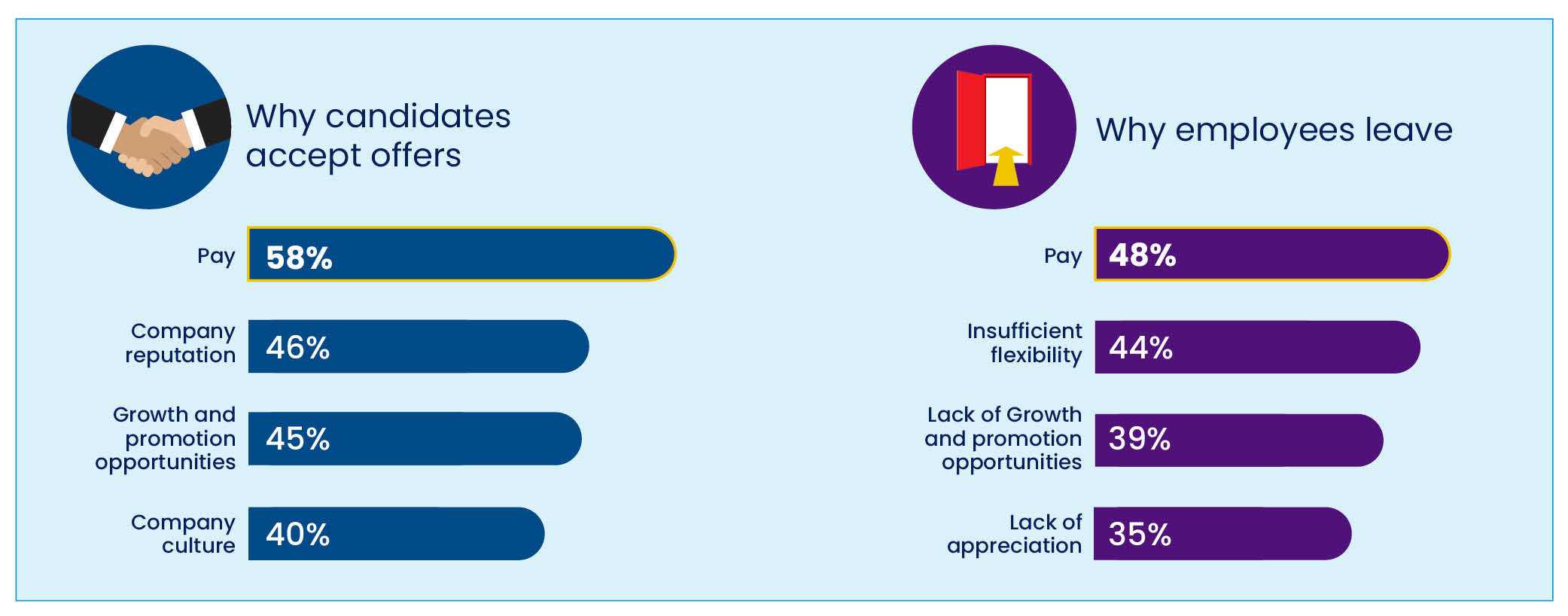- Seller well-being affects your customers’ experience. Invest in workplace flexibility programs and prioritize building a strong seller community to maintain high service quality.
- Apply commercial excellence principles to your talent pipeline. Treat employee retention as you would treat customer retention: prioritize developing existing sellers to maximize productivity and minimize turnover costs.
- Make competency measurement and development central to role and career path design. Adjust desired skillsets according to customer profile, buyer journey influence and product coverage, modulating training and career paths accordingly.
- Calibrate pay levels annually and ensure plan clarity to effectively pay for performance. Maximize the return on your biggest sales expense by ensuring sellers understand their compensation plan’s measures and mechanics – and that your plans are competitive.
- Widen the parameters for performance evaluation. Encourage frequent and open communication between sellers and sales managers to help ensure sellers feel appreciated while managers set clear and achievable expectations.
Ping-pong tables in the breakroom. Kombucha on tap. Hoverboards zooming across the office. Onsite perks that minimize the boundary between work and play are sensational ways of attracting and retaining creative and competitive talent.
The companies that lean into these perks prioritize developing a strong talent brand, highlighting the day-to-day experience of the seller as essential to operational success.
Course: Sales Compensation Course Series
However, a strong talent brand by itself won’t guarantee commercial success. Once a seller is hired, many other factors influence their ability — and willingness — to succeed long-term.
A recent Alexander Group survey of over 250 executives found that while company reputation, culture and pay are central to attracting candidates, the profile of why incumbents leave reveals.

Companies drawing a cleaner line between seller experience and commercial performance confirm that, just like a balanced diet, a balanced workplace experience must consist of much more than sugary perks.
Companies outpacing their industry in both revenue growth (+9%) and earnings before interest, taxes, depreciation and amortization (EBITDA) margin (+12%) complement their “talent brand” strengths with differentiators targeted to commercial execution. These profitable growth leaders have salesforces that reach clearly defined revenue goals more efficiently, also achieving significant savings on cost associated with seller turnover.

The Differentiating Traits of Profit Growth Leaders
They Invest in Seller Engagement
Beyond hiring top commercial talent, leaders reinforce seller motivation and ability to succeed. In contrast to companies imposing return-to-office policies, leaders use a more employee-centric model, formalizing flexibility through hybrid work policies, flexible work hours and leave of absence programs.
Rather than using a one-size-fits-all approach, which can feel impersonal and punitive to sellers, leaders formalize pathways, allowing talented sellers to select into working styles and career paths that optimize productivity, concurrently mitigating a major turnover risk.
Complementary to workplace flexibility, leaders also ensure that sellers feel integral to the success of their organization. Eighty percent of leaders formally solicit seller feedback (compared to 60% within the broader market), incorporating the voice of the employee into decisions around training, sales management and diversity, equity and inclusion (DEI) programs.
ROI: Companies with leading seller engagement practices have happier customers, with a 7% increase in average customer satisfaction score for both interactions with sales reps and service quality.
They Prioritize Long-Term Development and Mobility of Existing Talent
Not all companies achieve returns on their talent investments. Some hire inexperienced salespeople, invest in their training and development, but only retain them for a year or two before losing them to a competitor. Others look for hired gun sellers to enter or create new markets, mistakenly prioritizing the market over the salesforce and eventually losing their talent investment.
Leaders treat talent investments as they would treat customer acquisition investments, prioritizing the more cost-effective strategy of retaining individuals by building high-performing talent a suite of career offerings to choose from.
Profitable growth leaders are 16% more likely to formally communicate career advancement opportunities to their employees, including non-linear career paths. These companies also see 6% lower employee turnover cost, saving on both explicit and implicit expenditures, including talent acquisition costs, training and onboarding, lost productivity and employee morale.
ROI: Companies that formally communicate career advancement opportunities to employees fill open sales positions two weeks faster and ramp the sellers to full productivity two months faster.
They Design Jobs and Career Paths with Attention to Long-Term Skill Development
To formally offer sellers flexibility in working styles and career paths, companies must first reevaluate their job designs.
In addition to detailed job descriptions, holistic job capsules must identify the skills and competencies incumbents need to succeed, along with measurable key performance indications (KPIs) to inform performance evaluation conversations. Leaders also formalize sales time profiles and define rules of engagement to minimize overlap of effort and ambiguities in process ownership.
Job leveling frameworks create the next layer. As incumbents mature within their role, elements of the job capsule mature in step. Companies must distinguish how competencies and KPIs change along different levels of the same role and what thresholds prompt promotions or performance improvement conversations. Eighty-six percent of leaders formally measure seller skills, using these measurements to inform skill development pathways within the role and along career tracks.
ROI: Profitable growth leaders ramp sellers to full productivity 30% faster than peers, and those that formally track employee skills and competencies at least quarterly are 20% less likely to lose talent due to insufficient training.
They Focus on Paying for Performance Using Simple and Well-Understood Plans
Compensation is the most influential factor in candidates accepting sales positions, and the most-cited reason for sellers leaving. While many other factors for seller dissatisfaction lurk behind the scenes, compensation tends to be the final straw. In creating and revising compensation plans, successful companies balance employee satisfaction and performance. Sixty percent of companies source pay-level benchmarks at least annually to stay competitive in the talent market. They also ensure that compensation plans are clear and well-understood by sellers: 70% formally assess plans for seller comprehension, and leaders are 15% more likely to effectively execute these programs.
Leaders also clearly define eligibility requirements for incentive plans and set performance measures that incumbents can directly influence and that the company is equipped to quantify. They expand the scope of revenue influence beyond point of persuasion to include measurable contributions from marketing and service teams.
For example, leaders that put marketing roles on incentive plans use measures such as new contact acquisition (80%), return on marketing investment (78%) and marketing-attributed revenue (64%).
ROI: Profitable growth leaders achieve revenue growth and margin outperformance without demonstrating a higher proportion of above-market pay.
They Regularly Communicate Clear Yet Multifaceted Performance Expectations
Leaders use a more intimate and personalized coaching model, with a sales manager having one less seller on their team. They also don’t wait for annual performance evaluations to deliver feedback to their sellers. Forty-eight percent of leading sales managers have quarterly formal conversations with sellers, with 29% checking in monthly.
Regular performance discussions keep sellers on track to achieving their goals and equipped to handle sales challenges. Sales managers also use these discussions to communicate shifting priorities along with region or company performance, all helping the seller feel integrated in short-term priorities and long-term mission.
The substance of performance evaluations is just as important as cadence. Leaders are 15% more likely to measure employees on additional performance metrics other than quota attainment. Their formal evaluations include quantifiable conversations around sales competencies, new business, cultural contribution, manager assessments, all calibrated to time in role. Such multifaceted assessments help ensure that sellers’ efforts are holistically appreciated, mitigating one of the primary causes of seller turnover.
ROI: Smaller team sizes and more frequent high-quality performance discussions enable Profitable growth leaders to have an average of 15% more sellers achieving or exceeding sales quotas.
Ultimately, organizations that are reaping steady and profitable returns on their talent investments balance high-visibility perks that attract high-quality talent with strategic retention investments that ensure sellers have the flexibility, skills, motivation, and support to deliver their best performance long-term.
Editor’s Note: Additional Content
For more information and resources related to this article see the pages below, which offer quick access to all WorldatWork content on these topics:







